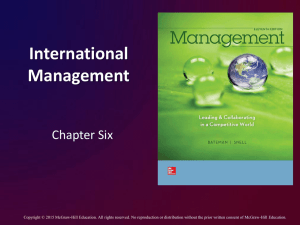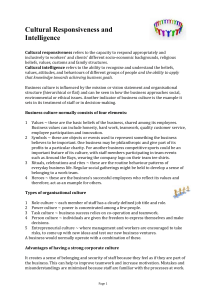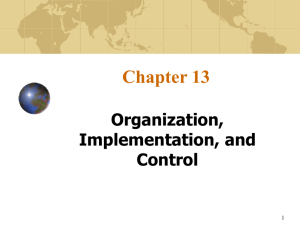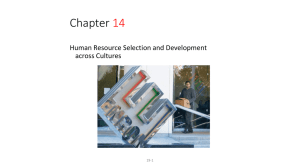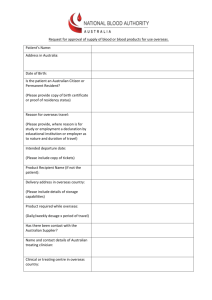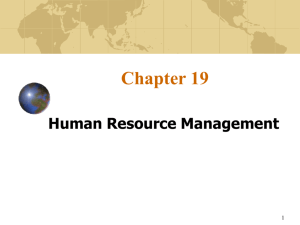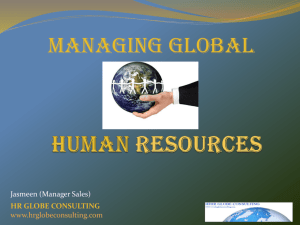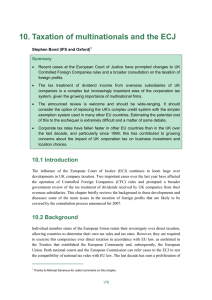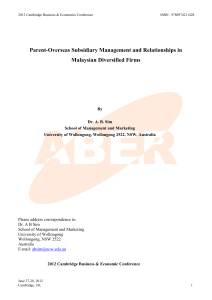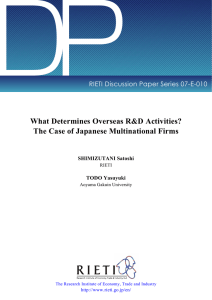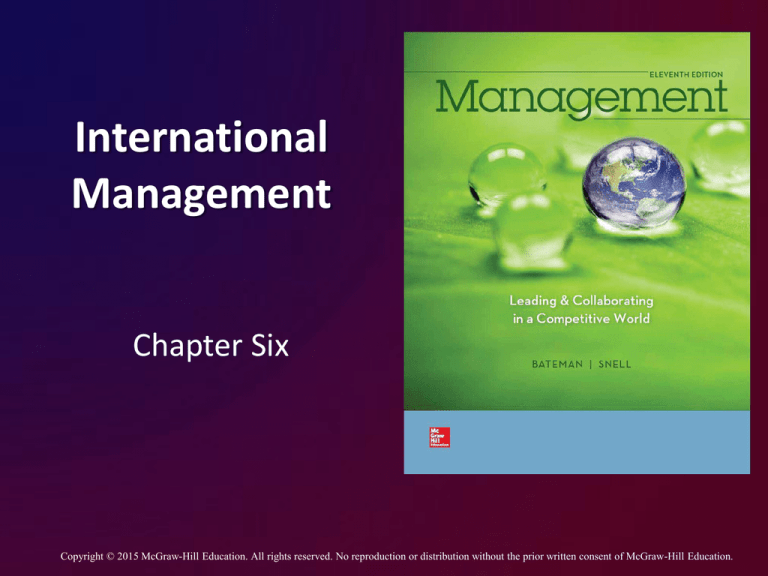
International
Management
Chapter Six
Copyright © 2015 McGraw-Hill Education. All rights reserved. No reproduction or distribution without the prior written consent of McGraw-Hill Education.
Learning Objectives
LO1 Discuss what integration of the global economy
means for individual companies and their
managers
LO2 Describe how the world economy is becoming
more integrated than ever before
LO3 Define the strategies organizations use to
compete in the global marketplace
LO4 Compare the various entry modes organizations
use to enter overseas markets
6-2
Learning Objectives (cont.)
LO5 Explain how companies can approach the
task of staffing overseas operations
LO6 Summarize the skills and knowledge
managers need to manage globally.
LO7 Identify ways in which cultural differences
across countries influence management
6-3
Implications of a Flat World
1. Expansion of international trade
2. Foreign direct investment (FDI) is playing an
3.
4.
ever-increasing role in the global economy
Imports are penetrating deeper into the
world’s largest economies
Companies are finding their home markets
under attack from foreign competitors
6-4
U.S. Exports as a Share
of U.S. Output
Figure 6.1
6-5
Implications of a Flat World
Opportunities are greater
Environment is more complex and
competitive
6-6
Relative Growth in World Merchandise
Exports by Major Product Group
Figure 6.2
6-7
The Role of Outsourcing
Outsourcing
Contracting with an
outside provider to
produce one or more
of an organization’s
goods or services.
Offshoring
Moving work to
other countries.
6-8
Factors to Consider for Offshoring
What is the competitive advantage of the
products they offer?
Is the business in its early stages?
Can production savings be achieved locally?
Can the entire supply chain be improved?
6-9
The Global Environment
The global economy
is dominated by
countries in three
regions: North
America, Western
Europe, and Asia
Other developing
countries and regions
represent important
areas for economic
growth
6-10
Key Issues of the Global
Environment
Table 6.1
6-11
European Unification
Europe is
integrating
economically to
form the biggest
market in the world
Certain structural
issues within Europe
need to be
corrected for the EU
to function
effectively.
6-12
Top U.S. Trading Partners
Based on Total Imports and Exports
Figure 6.4
6-13
Question
What economic pact that combined the
economies of the United States, Canada, and
Mexico?
A. HAFTA
B. NAFTA
C. EU
D. South American FTA
6-14
The Americas
North American Free Trade Agreement
(NAFTA)
An economic pact that combined the economies
of the United States, Canada, and Mexico into
one of the world’s largest trading blocs
6-15
Organizational Models
Figure 6.5
6-16
Choosing a Global Strategy
International model
composed of a company’s overseas subsidiaries
and characterized by greater control by the
parent company over the research function and
local product and marketing strategies than in
the multinational model.
6-17
Choosing a Global Strategy
Multinational model
consists of the subsidiaries in each country in
which a company does business and provides a
great deal of discretion to those subsidiaries to
respond to local conditions
6-18
Choosing a Global Strategy
Global model
consists of a company’s overseas subsidiaries and
characterized by centralized decision making and
tight control by the parent company over most
aspects of worldwide
operations
6-19
Choosing a Global Strategy
Transnational model
characterized by centralizing certain functions in
locations that best achieve cost economies
basing other functions in the company’s national
subsidiaries to facilitate greater local
responsiveness
fostering communication among subsidiaries to
permit transfer of technological expertise and
skills.
6-20
Comparison of Entry Modes
Table 6.2
6-21
Exporting
Advantages of exporting:
Provides scale economies by avoiding the
costs of manufacturing in other countries
Consistent with a pure global strategy
6-22
Licensing
International licensing
an arrangement by which a licensee in another
country buys the rights to manufacture a
company’s product in its own country for a
negotiated fee (typically, royalty payments on the
number of units sold)
6-23
Franchising
Franchising
the company sells limited rights to use its brand
name to franchisees in return for a lump-sum
payment and a share of the franchisee’s profits.
6-24
Joint Ventures
Joint ventures benefit a company through:
the local partner’s knowledge of the host
country’s competitive conditions, culture,
language, political systems, and business
systems
the sharing of development costs and/or risks
with the local partner.
6-25
Managing across Borders
Expatriates
Parent-company
nationals who are
sent to work at a
foreign subsidiary
6-26
Managing across Borders
Host-country
Third-country
nationals
nationals
Natives of the
Natives of a country
country where an
overseas subsidiary is
located
other than the home
country or the host
country of an
overseas subsidiary.
6-27
Stressors and Coping Responses in the
Developmental Stages of Expatriate Executives
Table 6.3
6-28
Skills of the Global Manager
15% of all employee transfers are to
international locations
Failure rate ranges from 20%-70%
Failure rate
the number of expatriate managers of an
overseas operation who come home early
communication is key to reducing the failure rate
6-29
Identifying International Executives
Table 6.4
6-30
How to Prevent Failed
Global Assignments
Table 6.5
6-31
Understanding Cultural Issues
Ethnocentrism
The tendency to
judge others by the
standards of one’s
group or culture,
which are seen as
superior
Culture shock
The disorientation
and stress associated
with being in a
foreign environment.
6-32
Understanding Cultural Issues
Power distance
the extent to which a
society accepts the
fact that power in
organizations is
distributed unequally
Individualism/
collectivism
the extent to which
people act on their
own or as a part of a
group.
6-33
Understanding Cultural Issues
Uncertainty
Masculinity/
avoidance
femininity
the extent to which
the extent to which a
people in a society
feel threatened by
uncertain and
ambiguous
situations.
society values
quantity of life over
quality of life
6-34
Positions of 40 Countries on the Power
Distance and Individualism Scales
Figure 6.6
6-35
Question
What is a foreign national brought in to work
at the parent company?
A. Expatriate
B. Non-patriate
C. Inpatriate
D. Unpatriate
6-36
Understanding Cultural Issues
Inpatriate
A foreign national
brought in to work
at the parent
company.
6-37
Understanding Cultural Issues
Americans tend to have specific views about the
purpose of meetings and how much time can be
spent.
International workers may have different
preconceptions about the nature and length of
meetings, and managers should make sure
foreign nationals are comfortable with the
American approach.
6-38
Understanding Cultural Issues
Workers from other countries can work long
hours but, in countries with strong labor
organizations, often get many more weeks of
vacation than American workers.
Europeans in particular may balk at working
on weekends.
6-39
Video: Wal-Mart - Push into Africa
What are some advantages of entering a
foreign market via an acquisition.?
Do you see any drawbacks to Wal-Mart’s
recent decision to acquire the Mass Mart
chain in South Africa?
6-40


